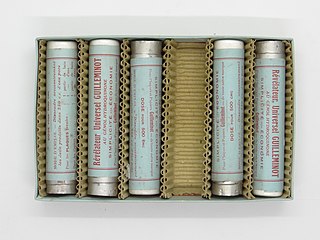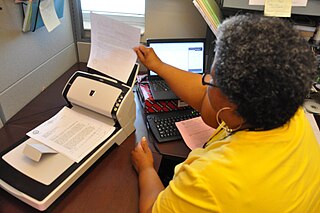Gallery
- Van Dyke brown example
- Brown print photogram
- Van Dyke copy of negative printed on transparent foil
Van Dyke brown is a printing process named after Anthony van Dyck.
It involves coating a canvas with ferric ammonium citrate, tartaric acid, and silver nitrate, then exposing it to ultraviolet light. The canvas can be washed with water, and hypo to keep the solutions in place. [1] The image created has a Van Dyke brown color when it's completed, and unlike other printing methods, does not require a darkroom. [2]
The Van Dyke brown process was patented in Germany in 1895 by Arndt and Troost. It was originally called many different names, such as sepia print or brown print. It has even been called kallitype, however that process uses ferric oxalate instead of ferric ammonium citrate. [3] [4]
Concerns have been voiced about the archival qualities of the Van Dyke brown print due to the fact that many early Van Dyke brown prints did not last long. However, if properly processed, Van Dyke brown prints should last as long as any other silver process. [3]

Printmaking is the process of creating artworks by printing, normally on paper, but also on fabric, wood, metal, and other surfaces. "Traditional printmaking" normally covers only the process of creating prints using a hand processed technique, rather than a photographic reproduction of a visual artwork which would be printed using an electronic machine ; however, there is some cross-over between traditional and digital printmaking, including risograph.

A blueprint is a reproduction of a technical drawing or engineering drawing using a contact print process on light-sensitive sheets introduced by Sir John Herschel in 1842. The process allowed rapid and accurate production of an unlimited number of copies. It was widely used for over a century for the reproduction of specification drawings used in construction and industry. Blueprints were characterized by white lines on a blue background, a negative of the original. Color or shades of grey could not be reproduced.

The cyanotype is a slow-reacting, photographic printing formulation sensitive to a limited near ultraviolet and blue light spectrum, the range 300 nm to 400 nm known as UVA radiation. It produces a monochrome, blue coloured print on a range of supports, often used for art, and for reprography in the form of blueprints. For any purpose, the process usually uses two chemicals: ferric ammonium citrate or ferric ammonium oxalate, and potassium ferricyanide, and only water to develop and fix. Announced in 1842, it is still in use.

In the processing of photographic films, plates or papers, the photographic developer is one or more chemicals that convert the latent image to a visible image. Developing agents achieve this conversion by reducing the silver halides, which are pale-colored, into silver metal, which is black when in the form of fine particles. The conversion occurs within the gelatine matrix. The special feature of photography is that the developer acts more quickly on those particles of silver halide that have been exposed to light. When left in developer, all the silver halides will eventually be reduced and turn black. Generally, the longer a developer is allowed to work, the darker the image.

The albumen print, also called albumen silver print, is a method of producing a photographic print using egg whites. Published in January 1847 by Louis Désiré Blanquart-Evrard, it was the first commercial process of producing a photo on a paper base from a negative, previous methods - such as the daguerreotype and the tintype - having been printed on metal. It became the dominant form of photographic positives from 1855 to the start of the 20th century, with a peak in the 1860–90 period. During the mid-19th century, the carte de visite became one of the more popular uses of the albumen method. In the 19th century, E. & H. T. Anthony & Company were the largest makers and distributors of albumen photographic prints and paper in the United States.

The gelatin silver process is the most commonly used chemical process in black-and-white photography, and is the fundamental chemical process for modern analog color photography. As such, films and printing papers available for analog photography rarely rely on any other chemical process to record an image. A suspension of silver salts in gelatin is coated onto a support such as glass, flexible plastic or film, baryta paper, or resin-coated paper. These light-sensitive materials are stable under normal keeping conditions and are able to be exposed and processed even many years after their manufacture. The "dry plate" gelatin process was an improvement on the collodion wet-plate process dominant from the 1850s–1880s, which had to be exposed and developed immediately after coating.

Platinum prints, also called platinotypes, are photographic prints made by a monochrome printing process involving platinum.

Photoengraving is a process that uses a light-sensitive photoresist applied to the surface to be engraved to create a mask that protects some areas during a subsequent operation which etches, dissolves, or otherwise removes some or all of the material from the unshielded areas of a substrate. Normally applied to metal, it can also be used on glass, plastic and other materials.
The science of photography is the use of chemistry and physics in all aspects of photography. This applies to the camera, its lenses, physical operation of the camera, electronic camera internals, and the process of developing film in order to take and develop pictures properly.

Sun printing may refer to various printing techniques which use sunlight as a developing or fixative agent.

The term alternative process refers to any non-traditional or non-commercial photographic printing process. Currently, the standard analog photographic printing process for black-and-white photographs is the gelatin silver process. Standard digital processes include the pigment print, and digital laser exposures on traditional color photographic paper.

In photography, toning is a method of altering the color of black-and-white photographs. In analog photography, it is a chemical process carried out on metal salt-based prints, such as silver prints, iron-based prints, or platinum or palladium prints. This darkroom process cannot be performed with a color photograph. The effects of this process can be emulated with software in digital photography. Sepia is considered a form of black-and-white or monochrome photography.

The history of photography began with the discovery of two critical principles: The first is camera obscura image projection; the second is the discovery that some substances are visibly altered by exposure to light. There are no artifacts or descriptions that indicate any attempt to capture images with light sensitive materials prior to the 18th century.

Kallitype is a process for making photographic prints.
Chrysotype is a photographic process invented by John Herschel in 1842. Named from the Greek for "gold", it uses colloidal gold to record images on paper.

Architectural reprography, the reprography of architectural drawings, covers a variety of technologies, media, and supports typically used to make multiple copies of original technical drawings and related records created by architects, landscape architects, engineers, surveyors, mapmakers and other professionals in building and engineering trades.

Monochrome photography is photography where each position on an image can record and show a different amount of light (value), but not a different color (hue). The majority of monochrome photographs produced today are black-and-white, either from a gelatin silver process, or as digital photography. Other hues besides grey can be used to create monochrome photography, but brown and sepia tones are the result of older processes like the albumen print, and cyan tones are the product of cyanotype prints.
Argyrotype is an iron-based silver printing process that produces brown images on plain paper. It is an alternative process derived from the Argentotype, Kallitype, and Van Dyke processes of the 19th century, but has greater simplicity, improved image stability, and longer sensitizer shelf-life. The Argyrotype process was developed by Mike Ware in the 1990s.
A heliographic copier or heliographic duplicator is an apparatus used in the world of reprography for making contact prints on paper from original drawings made with that purpose on tracing paper, parchment paper or any other transparent or translucent material using different procedures. In general terms some type of heliographic copier is used for making: Hectographic prints, Ferrogallic prints, Gel-lithographs or Silver halide prints. All of them, until a certain size, can be achieved using a contact printer with an appropriate lamp but for big engineering and architectural plans, the heliographic copiers used with the cyanotype and the diazotype technologies, are of the roller type, which makes them completely different from contact printers.